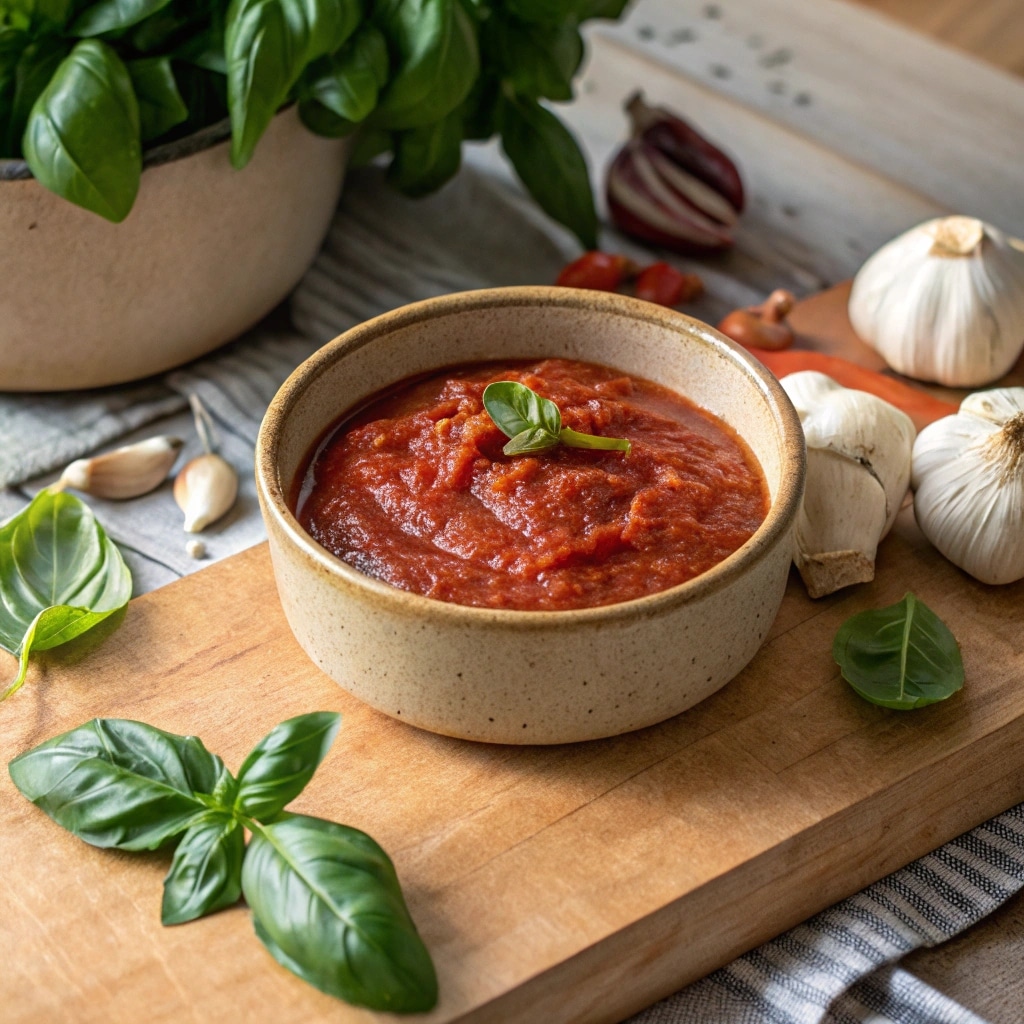Making a true Italian pizza sauce recipe at home doesn’t have to be complicated. Whether you’re using fresh tomatoes, tomato paste, or even canned tomato sauce, there’s always a way to get that real Italian pizzeria flavor right in your kitchen. This guide walks you through everything from the basic recipe to expert secrets from chefs like Gordon Ramsay. We’ll also break down common mistakes to avoid and how to match your sauce with the perfect pizza or side.
Looking for inspiration? Try our air-fry Totino’s pizza method to go with your new sauce.
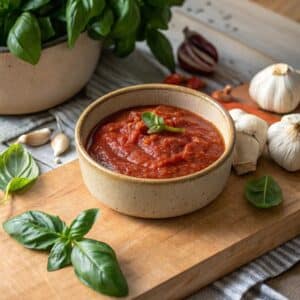
Authentic Italian Pizza Sauce
Equipment
Ingredients
- 1 can (28 oz) San Marzano tomatoes
- 2–3 cloves garlic, minced
- 2 tbsp extra virgin olive oil
- 1 tsp sea salt
- 1 tsp dried oregano
- 1 handful fresh basil leaves, torn
- 1 pinch red chili flakes (optional)
Instructions
- Pour the San Marzano tomatoes into a large bowl. Gently crush them by hand or with a potato masher until chunky but not fully smooth.
- Add the minced garlic and olive oil directly to the bowl. Stir to combine and infuse flavor without cooking.
- Season the sauce with sea salt, dried oregano, and torn fresh basil leaves. Add a pinch of chili flakes if desired.
- Let the sauce rest at room temperature for 30 minutes to allow the flavors to blend naturally.
- Spread the uncooked sauce directly on your pizza dough before baking. The sauce will cook perfectly in the oven with the pizza.
Notes
Nutrition
Table of contents
Table of Contents
WhaPART 1: What Makes an Italian Pizza Sauce Recipe Truly Authentic?
Traditional Ingredients in a Real Italian Pizza Sauce Recipe
When you’re aiming to craft a real Italian pizza sauce recipe, it all begins with simple, high-quality ingredients. Italian cooking is known for its restraint—letting every element shine without overwhelming the dish. A true Italian pizza sauce recipe keeps things clean, fresh, and minimal.
Here’s what you’ll usually find in a classic recipe:
- San Marzano tomatoes – prized for their rich, slightly sweet flavor and low acidity
- Garlic – crushed or minced to infuse the sauce with a warm depth
- Extra virgin olive oil – smooth and aromatic, essential for richness
- Sea salt – to enhance natural tomato flavor
- Fresh basil leaves – add that signature Italian aroma and freshness
- Oregano – usually dried, used lightly for a subtle herb note
In a traditional Italian pizza sauce recipe, you won’t see onions, heavy spices, or sugar. That’s because the goal is to let the tomatoes and herbs do the talking. Unlike American-style sauces, Italians skip the sugar and keep the texture light and rustic.
Why an Italian Pizza Sauce Recipe Stands Out
So, what sets a real Italian pizza sauce recipe apart from others?
- No cooking needed upfront
Most authentic recipes don’t involve cooking the sauce before it goes on the dough. The tomatoes are crushed or blended, then seasoned. Once baked in a hot oven, the sauce cooks just enough on the pizza itself. - Minimal ingredients, maximum flavor
You won’t find long ingredient lists. That’s because the combination of great tomatoes, a touch of garlic, olive oil, and herbs is more than enough. - Texture that complements, not competes
A proper Italian pizza sauce recipe creates a smooth, slightly loose sauce. It spreads easily without drowning the crust. The goal is to enhance the pizza—not overpower it. - Balanced seasoning
The flavors are meant to blend with mozzarella, dough, and toppings. It’s not overly salty or spiced. Everything is in harmony.
If you’re searching for a straightforward, flavorful Italian pizza sauce recipe, this guide has got you covered. Up next, we’ll show you the easiest way to make it at home with foolproof steps anyone can follow.
How to Make the Best Italian Pizza Sauce at Home
Step-by-Step Italian Pizza Sauce Recipe with Classic Flavor
Crafting a delicious Italian pizza sauce recipe at home doesn’t take hours or expensive ingredients. In fact, the best recipes rely on what’s already in your pantry. Below is a simple and traditional method used by home cooks across Italy.
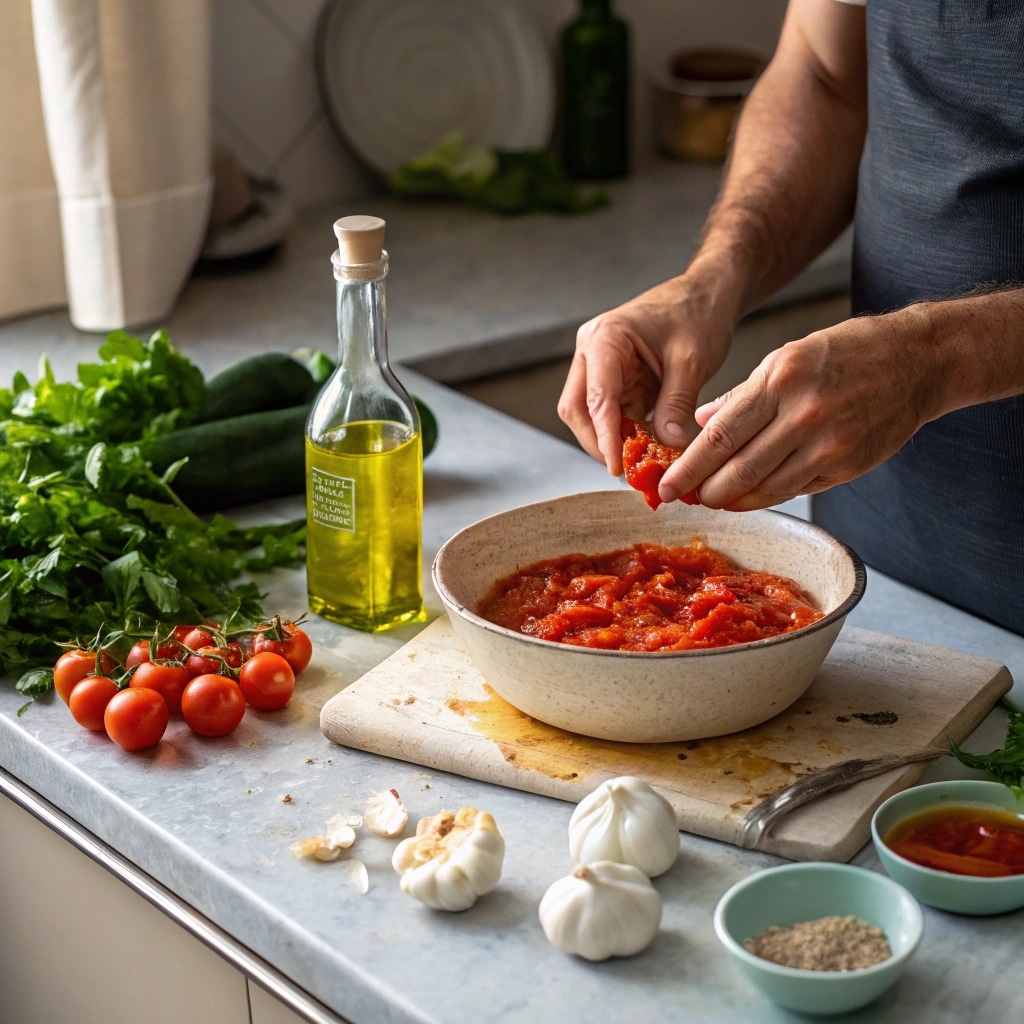
Ingredients You’ll Need
| Ingredient | Quantity |
|---|---|
| San Marzano tomatoes | 1 can (28 oz) |
| Garlic (fresh, minced) | 2–3 cloves |
| Extra virgin olive oil | 2 tablespoons |
| Fresh basil leaves | Handful, torn |
| Dried oregano | 1 teaspoon |
| Salt | 1 teaspoon |
| Optional: Chili flakes | Pinch |
Instructions
- Crush the Tomatoes
Pour the tomatoes into a bowl. Use clean hands or a potato masher to gently crush them until chunky but not fully smooth. - Add Garlic and Olive Oil
Stir in the minced garlic and olive oil directly into the tomato mixture. This adds richness and aroma without needing to sauté. - Season It
Toss in the oregano, salt, and torn basil leaves. Mix well. If you’re feeling adventurous, add a pinch of chili flakes for a slight kick. - Let It Sit
For the best flavor, let your Italian pizza sauce recipe rest at room temperature for 30 minutes before using. This allows all the flavors to blend naturally. - Spread and Bake
No need to cook the sauce! Spread it over your pizza dough, add your favorite toppings, and bake. The sauce will cook perfectly in the oven with the pizza.
This method respects Italian tradition by keeping the sauce fresh, bright, and deeply tomato-forward. There’s no added sugar, and no overcooking. Just pure, simple goodness.
Tips for Balancing Herbs, Acidity, and Tomato Sweetness
While tomatoes bring the body of your Italian pizza sauce recipe, it’s the seasoning that builds the personality. Here’s how to keep things balanced:
- Too sour? Add a pinch of baking soda, not sugar. It neutralizes acidity without altering flavor.
- Too bland? A splash of olive oil or a bit more salt can round it out.
- Herbs too strong? Let the sauce rest longer—time helps blend flavors.
Another tip: If using store-bought tomatoes, always taste them first. Not all canned tomatoes are the same. Go for quality Italian imports whenever possible.
Don’t miss our guide to avocado salad dressing for light, fresh side pairings.
Recipe for Pizza Sauce Using Tomato Paste
Why Tomato Paste Works Great in an Italian Pizza Sauce Recipe
If you’re low on fresh or canned tomatoes, don’t worry—tomato paste can step up as a strong substitute. It’s thick, concentrated, and packed with flavor, which makes it ideal for a quick Italian pizza sauce recipe. Plus, it’s easy to store and has a long shelf life.
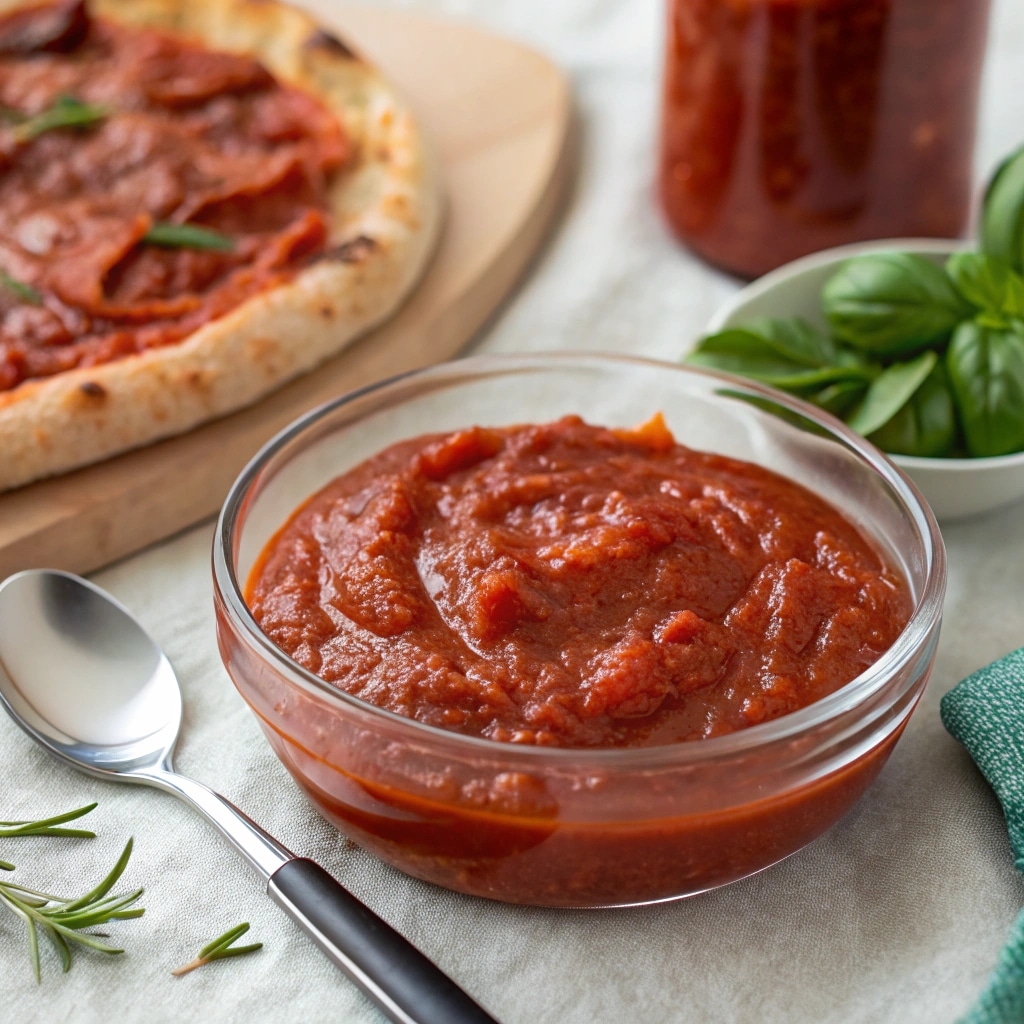
Tomato paste offers:
- A rich and bold tomato flavor
- A thick texture that spreads easily on pizza dough
- A faster cooking (or no-cook) method compared to fresh tomatoes
This method is especially useful on weeknights or when you’re prepping multiple pizzas.
Tomato Paste Pizza Sauce: Quick and Easy Recipe
You don’t need a long list of ingredients. This simple pizza sauce from tomato paste gives you that classic Italian flavor with minimal fuss.
Ingredients You’ll Need
| Ingredient | Quantity |
|---|---|
| Tomato paste | 6 oz (1 small can) |
| Water | ½ cup (adjust to texture) |
| Garlic powder | ½ teaspoon |
| Dried oregano | 1 teaspoon |
| Salt | ½ teaspoon |
| Olive oil | 1 tablespoon |
| Fresh basil (optional) | A few leaves |
Instructions
- Mix the Base
In a medium bowl, combine the tomato paste and water. Stir until smooth. You can adjust the water depending on how thick or thin you want the sauce. - Season the Sauce
Add garlic powder, oregano, and salt. Stir in the olive oil, which helps bring out that rich tomato flavor and gives the sauce a silky finish. - Optional Touch of Fresh Herbs
For an extra hint of freshness, tear in a few fresh basil leaves. - Use Right Away or Chill
This Italian pizza sauce recipe using tomato paste doesn’t need any cooking. Spread it directly on your pizza base, or refrigerate it for up to 5 days.
Check out this delicious lemon-balm recipe for weight loss for a refreshing drink to go with your homemade pizza night.
Flavor Boosting Add-Ins for Tomato Paste Sauce
Want to build even more flavor? Here are a few optional additions that work well with tomato paste:
- A pinch of red chili flakes for heat
- A small splash of balsamic vinegar for sweetness and tang
- Finely grated parmesan cheese mixed in for depth
Because tomato paste is so concentrated, it absorbs flavors quickly. This allows your Italian pizza sauce recipe to taste like it’s been simmering all day—even though it only took five minutes.
Pizza Sauce from Tomato Sauce – Easy Method
Converting Tomato Sauce into a True Italian Pizza Sauce Recipe
If all you have is a can of plain tomato sauce, don’t worry—you’re just a few steps away from a proper Italian pizza sauce recipe. While tomato sauce is thinner than tomato paste, it provides a smooth and ready base. With the right seasoning, it becomes rich, tangy, and perfect for any homemade pizza.
This method is ideal for:
- Beginners looking for a no-fail option
- Pizza nights on a tight schedule
- A lighter sauce with a clean tomato taste
Quick Recipe: Pizza Sauce from Tomato Sauce
With this shortcut, you’ll go from basic tomato sauce to flavorful pizza topping in just 10 minutes.
Ingredients You’ll Need
| Ingredient | Quantity |
|---|---|
| Tomato sauce | 15 oz can |
| Minced garlic | 1 clove |
| Olive oil | 1 tablespoon |
| Dried oregano | 1 teaspoon |
| Dried basil | ½ teaspoon |
| Salt | ½ teaspoon |
| Optional: Red pepper flakes | Pinch |
Instructions
- Warm the Olive Oil and Garlic
In a small saucepan over medium heat, sauté the garlic in olive oil for about 30 seconds—just enough to release its aroma. - Add the Tomato Sauce
Pour in the tomato sauce and stir well. Let it gently simmer for 5–7 minutes. - Season It Up
Mix in oregano, basil, salt, and chili flakes if using. Stir and taste. Simmer for another 2–3 minutes to blend the flavors. - Cool and Use
Let the sauce cool slightly before spreading it onto your pizza dough. This ensures the dough stays firm and doesn’t get soggy.
This variation gives you a thicker, more robust sauce that still follows the principles of a traditional Italian pizza sauce recipe—simple, balanced, and tomato-focused.
Don’t miss our guide to homemade pistachio butter for an easy, rich spread to enjoy as a snack or dessert alongside pizza night.
Tips for Better Tomato Sauce-Based Pizza Sauce
Even with store-bought tomato sauce, you can get amazing results by:
- Choosing no-salt-added or low-sodium versions to control the final flavor
- Avoiding sauces with added sugar or spices that may clash with your pizza
- Simmering uncovered to slightly thicken the sauce and reduce moisture
This version of the Italian pizza sauce recipe works especially well for thin-crust or Margherita-style pizzas, where the sauce needs to be light but flavorful.
Pizza Sauce vs. Italian Sauce – Know the Difference
Key Flavor and Texture Differences Explained
It’s easy to assume all tomato-based sauces are the same, but there’s a big difference between a classic Italian pizza sauce recipe and other Italian sauces like marinara or spaghetti sauce.
Here’s how they compare:
| Feature | Italian Pizza Sauce | Italian Pasta Sauce (e.g. Marinara) |
|---|---|---|
| Cooking Method | Usually uncooked or lightly simmered | Cooked slowly for deeper flavor |
| Texture | Thick, smooth, spreadable | Thinner, chunkier for coating pasta |
| Seasoning | Minimal herbs, no sugar | More garlic, onion, sometimes sugar |
| Use | Meant to bake with dough | Simmered on stovetop for pasta |
An Italian pizza sauce recipe is designed to hold up under high heat. It doesn’t contain added water or oil that could make the pizza soggy. In contrast, Italian pasta sauces are often simmered longer and contain more aromatic ingredients.
When to Use Pizza Sauce vs. Other Italian Sauces in Cooking
Use pizza sauce for:
- Classic homemade or Neapolitan-style pizzas
- Calzones and strombolis
- Dipping sauce for breadsticks and garlic knots
Use Italian pasta sauce for:
- Spaghetti and penne dishes
- Eggplant Parmesan
- Lasagna or baked ziti
If you’re unsure what you’re working with, check the consistency. If it’s pourable and chunky, it’s likely a pasta sauce. If it’s thick, spreadable, and slightly raw-tasting, you’ve got yourself a true Italian pizza sauce recipe.
Check out this vibrant avocado toast recipe for a light lunch option to balance out your pizza dinner.
Serving Ideas & Pairings with Italian Pizza Sauce
Perfect Pizzas to Pair with Homemade Italian Sauce
Once you’ve nailed the perfect Italian pizza sauce recipe, the next step is matching it with the right kind of pizza. Here are a few mouth-watering combinations:
| Pizza Type | Sauce Pairing Notes |
|---|---|
| Margherita | Keep it simple—just your sauce, fresh mozzarella, and basil |
| Pepperoni | The bold tomato base balances the spicy meat |
| Veggie Pizza | A thin layer of sauce highlights the fresh toppings |
| Four Cheese | Sauce provides a sweet contrast to sharp cheeses |
| Sicilian Thick-Crust | Thicker sauce holds up to heavier toppings and dough |
When spreading your sauce, don’t go overboard. A light, even coat is all you need—too much can make the crust soggy.
Other Dishes to Use Italian Pizza Sauce Beyond Pizza
Your Italian pizza sauce recipe can go far beyond just pizza. Try it with these ideas:
- Mozzarella sticks: Use as a dipping sauce instead of marinara
- Stuffed bell peppers: Mix with rice and cheese for an Italian twist
- Grilled cheese: Add a thin layer of pizza sauce inside the sandwich before grilling
- Eggplant or zucchini stacks: Layer roasted slices with sauce and cheese
- Baked pasta cups: Line muffin tins with pasta, cheese, and a spoonful of sauce
Discover great ideas like our air fryer smashed potatoes to serve as a crispy, salty side with any of these recipes.
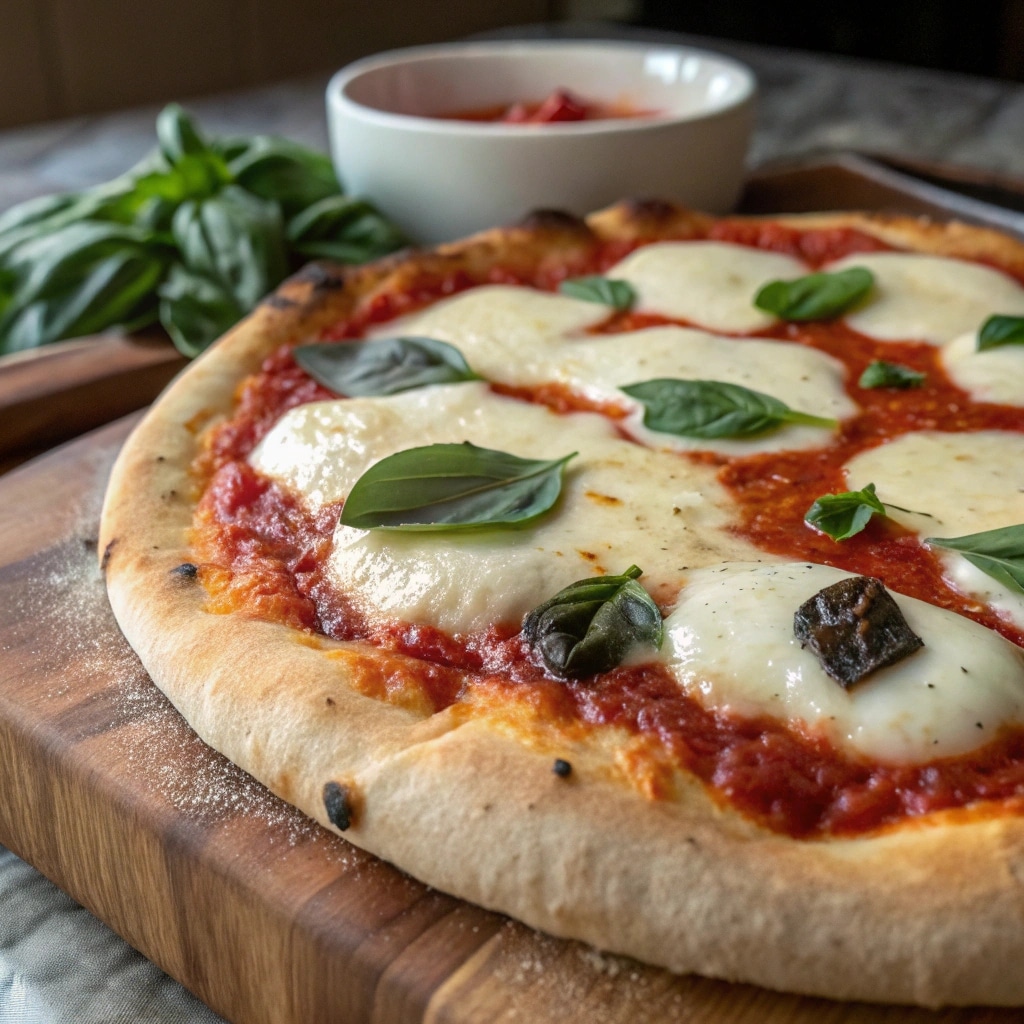
FAQs
How to make Italian sauce for pizza?
To make a traditional Italian pizza sauce recipe, start with high-quality tomatoes—preferably San Marzano. Crush them gently by hand or with a masher, then stir in olive oil, minced garlic, salt, oregano, and fresh basil. Let it sit at room temperature for 30 minutes. The sauce doesn’t need cooking before it goes on the dough—it cooks perfectly in the oven with the pizza.
What is the secret of Italian pizza?
The real secret lies in simplicity and quality. Authentic Italian pizza uses just a few fresh ingredients—flour, water, yeast, and salt for the dough, and a simple Italian pizza sauce recipe made from fresh tomatoes, herbs, and olive oil. Italians never overload the pizza with toppings. Balance and harmony in flavor are key.
How does Gordon Ramsay make pizza sauce?
Gordon Ramsay keeps his pizza sauce straightforward. He typically starts with peeled plum tomatoes or San Marzano tomatoes, adds fresh garlic, olive oil, and basil, then blends the ingredients without cooking them. The goal is to keep the sauce fresh and vibrant so it bakes beautifully on the pizza.
What’s the difference between pizza sauce and Italian sauce?
The main difference is in preparation and use. A pizza sauce is usually uncooked, thick, and made to be baked on the dough. Italian sauces like marinara are cooked on the stove and used with pasta or meat. Pizza sauce also uses fewer ingredients and minimal herbs, so it doesn’t overpower the pizza.
Conclusion: Keep It Simple with the Right Italian Pizza Sauce Recipe
Whether you’re using fresh tomatoes, canned tomato sauce, or even tomato paste, the beauty of a real Italian pizza sauce recipe lies in its simplicity. There’s no need to complicate it. A few good ingredients and a light hand with seasoning are all it takes to create a sauce that brings your homemade pizza to life.
From quick weekday meals to weekend pizza parties, this guide gives you multiple ways to make your sauce exactly how you like it. The best part? You control every ingredient.
Check out our simple avocado toast recipe for another easy homemade dish that pairs perfectly with casual family meals.
for more recipes follow us in Pinterest

